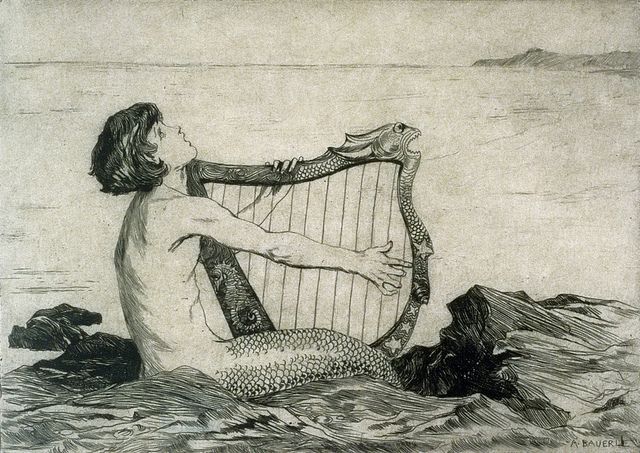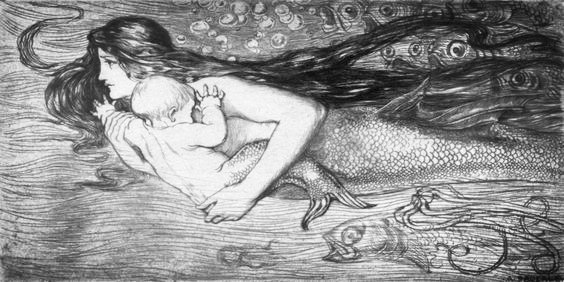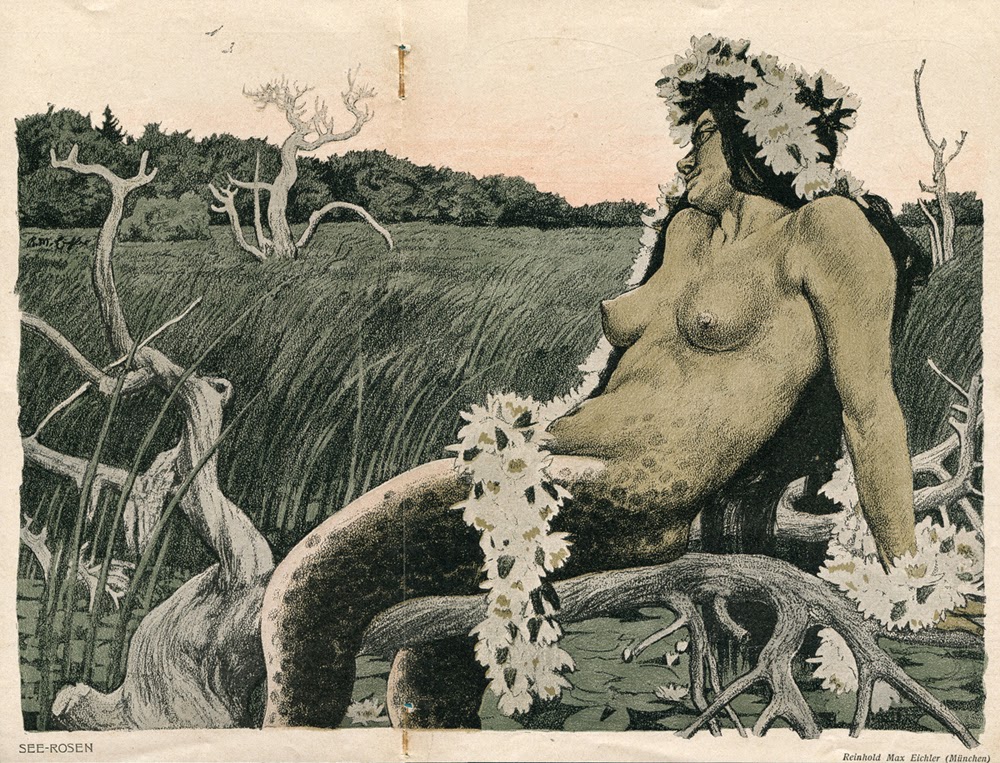
My next book, Beyond Faery, will be published by Llewellyn Worldwide in early November. It examines the variety of ‘faery beasts’ that exist alongside the traditional faeries we’re familiar with- the kelpies, water bulls, black dogs, hobgoblins and others that make Faery so complex, fascinating- and dangerous. For the next few weeks I’m going to examine some of these beings, using materials I’ve come across in my researches since the text of Beyond Faery was completed. This week, we start in the ocean.

A Mermaid by Jasmine Beckett-Griffith (with a nod to Böcklin’s Isle of the Dead)
Strange Fish
“Faith, I do grant,
This is the strangest Fish… some
Say ‘tis an o’er-grown Porpoise, others say,
‘Tis the fish caught in Cheshire; one, to whom
The rest agree, said that ‘twas a Mermaid.”
(Jasper Maine, The City Match, 1639, Act III, scene 1)
The merfolk- the mermaids and the selkies- have long fascinated humankind. They are a complex as well as a beautiful people and both men and women seem to be drawn inexorably towards them.
There are in fact many different types of supernatural inhabiting the seas. We are familiar with the mermaids (half-human, half-fish) and the selkies (humans who can put on a seal skin in order to travel through the sea) but in addition to these there are, for example:
- Sea fairies– Cornish folklorist and writer Enys Tregarthen described these as being amongst the fairy family, but able to ride the waves. She also identified cliff fairies, whose traits include a desire for doing good and healing injured animals and a liking for singing and dancing at dawn or sunset and,
- Sea trows– on Orkney and Shetland the local fae folk, the trows, also inhabit the ocean and are said to be “great rolling creatures, tumbling in the waters” which are sometimes pulled up in fishermen’s nets.
“Yee mermaids faire,
That on the shores do plaine,
Your sea-greene haire
As yee in trammels knit your locks
Weepe ye; and so inforce the rocks
In heavy murmurs through the broad shores tell.”
(William Browne, Britannia’s Pastorals, II, Song I)

Mermaid beauty
The best known trait of the mermaid is, of course, her physical beauty and desirability. In fact, traditional folklore is divided over the actual appearance of these beings. One story from Shetland typifies the standard views. Young Maikie found a selkie on some offshore rocks, a distance from her seal skin, which she’d shed on the beach. He responded in the conventional way to her physical charms, admiring her snow white body, her fine legs and her bonnie yellow hair. He hid her skin, offered her human clothes to wear and asked her to be his wife (which she was for a number of years, until she found her skin again and escaped to the sea).
Another account was less complimentary: a mermaid encountered near Buchan was discovered combing her long brown hair hair- a traditional activity. She had a small upper body with a thin neck, round head and small, flat face with white thick set teeth and small eyes. Her lower half was like a cod, but with a double tail.
A selection of other nineteenth century accounts reinforce the impression that the merfolk resemble us, but that their reported good looks are not always all that we tend to imagine:
- Campbelltown, Argyll, 1811: a man was able to creep with a few paces of a mermaid lying on a rock and watched her for two hours. She was six to seven feet in length, the upper half being white and the lower half brindled or reddish grey and covered in scales, terminating in a fin that was of greenish-red and shining, about twelve to fourteen inches wide. The upper half was human, except that the arms were short and thin. The creature had long brown hair and a human face with hollow eyes;
- Ardeal, Argyll, 1814: the mermaid seen was very white, but with rosy cheeks. She had long dark hair and arms that tapered to her hands, which were said to be only the size of those of an eight to ten year old child. Her tail was like that of an immensely large cuddy fish or saith;
- Port Charlotte, Argyll, 1857: a woman was seen in the sea at close range. She had a full breast, dark complexion, fine hair in ringlets and a comely face;
- Southside, Deerness, Orkney, 1890-94: a mermaid returned regularly to this spot in the summer months. She was six to seven feet in length, with a little black head, white neck and a snow white body. She sat on a rock waving her hands about; and,
- lastly, older accounts still, from Tudor and Stuart times, record the “whooping noise” that the merfolk made and their sea green hair. The mermaid’s long hair is frequently matched by the copious beards of the mermen.
The eyewitness descriptions are less consistently complimentary, then, and as Swan wrote in Speculum Mundi of 1634, “Mermaids and Menfish seem to me the most strange fish.”
All the same, the consensus seems to be that mermaids have a high opinion of their own good looks. They are reputed to be very vain and their traditional attributes are a comb and a mirror, with which they pass hours sitting on rocks, combing their long hair (admittedly, one seen at Mumbles near Swansea in 1893 was combing her hair with a mackerel’s back bone). They are also very partial to jewellery and can be wooed with rings and necklaces.
The most recent accounts don’t question the mermaids’ charms and it is very true to say that they are regularly sought by human males as their spouses. As in the earlier example, selkies are continually portrayed as being captured and forced into marriage by men. However, the traffic is not all one way. Dora Broome in her Fairy Tales from the Isle of Man describes a mermaid who developed an obsessive passion for a young man from Port Le Murrey, and nearly managed to lure him away with her charms. In another Shetland story, a girl gathering shell-fish on a beach fell asleep in a cave after sitting down to eat her lunch. Some months later she discovered she was pregnant and, when the baby was born, it had flippers instead of hands. This she explained by the fact that, as she had wandered along the beach that day, she had been watched by a seal offshore. It would seem that this creature had, in fact, been a selkie and that he had taken advantage of her sleep to rape her. The best we can say about the selkie’s conduct is this: the girl then learned in a dream that, if she went to a nearby sea inlet, she would find silver coins that would pay for the child’s upbringing.
The love of a mermaid can be perilous and, on the Isle of Man, there seemed to be a settled procedure for freeing a hapless fisherman from a mermaid’s attentions. To do this he needed help- and the right preparations. Herring roe had to be boiled for three days and then dried and ground into a powder. The human victim would consume this in a drink and then set to sea, protected by sprigs of vervain and a cross made of rowan wood. As soon as the mermaid began to follow the boat, a charm had to be repeated:
“Ben-varrey, ben-varrey- go back to thy home,
Til the sea from this island of Mannin doth roam,
Find a mate with a tail, for if thou X should wed,
In the deeps of the sea he’ll be drownded and dead.”
As soon as this verse has been completed, the vervain should be dropped in the waves and an iron knife should be stuck in the mast, which will summon up a storm, driving the mermaid beneath the surface and the ship back to land.

Merfolk habits
The merfolk are, of course, not just love interest for humans. They have an independent and separate life. They are said to herd fish out at sea and they have control over the weather and sea conditions, so that when breakers drive up onto the shore, the Welsh say “The mermaid is driving her sheep.”
The merfolk’s supernatural powers are attested by a story from Padstow in Cornwall. A man called Tristram Bird bought a hunting rifle and went out to try to shoot a seal. Instead, he found a mermaid combing her hair and instantly conceived a passion for her. She rejected his advances and his offer of marriage; he became angry and threatened to shoot her. She warned him he’d be sorry but he fired off a shot anyway- in revenge for which she cursed Padstow’s harbour. Very soon afterwards, a storm arose that created a sandbar across the mouth of the harbour, cutting it off from the sea. It’s very evidently inadvisable to annoy or hurt a mermaid- on the Isle of Man it is said that if you vex a mermaid, you will never have an luck when you’re out fishing.
Mermaids are also said to pursue ships out at sea, trying to sink them. In the old ballad, The Mermaid, she’s seen by the crew of a ship with her mirror, combing her hair. They instantly despair of reaching their homes- rightly, because she circles the ship three times- and then it sinks. So strong was this belief that in Shakespeare’s Henry VI (Part III, Act III, scene 2) it is declared “I’ll drown more sailors than the mermaid shall.”
The merfolk can foresee bad weather. At Lamorna Cove in West Cornwall, a mermaid would appear, floating head and shoulders above the waves, whenever a storm was approaching. On the small Channel Island of Sark, it’s said that the mermaids sit on rocks and sing before storms develop. It’s not entirely clear from this whether they are foreseeing or actually causing the bad weather. Folklorist Edgar MacCulloch reported this information and then observed that sailors on ships are attracted by the sound of the singing and come too close to shore, where they are then caught when the storm breaks. This juxtaposition suggests he regarded the mermaids as malign and culpable.
It’s plain that merfolk need to be treated with cautious respect. Around the Isle of Man mermaids are seemingly more numerous than mermen- they are certainly seen more frequently- and wise sailors know that, when they’re out at sea, they should never refer to them by the names used on land, so that the mermaid, the ben-varrey or pohllinagh, is called instead Joaney Gorm (‘Blue Joan’), a habit which must be linked to the name taboo so often found in folklore accounts.

Mermaid gifts
Destructive as they may be, merfolk can also be healers. As I’ve mentioned before, they are known for their understanding of herbs’ healing properties and they can pass on these skills and knowledge to chosen humans- often those who’ve done them a good turn, such as carrying them back to the sea when they’ve become stranded.
Mermaids can be a source of riches, as well as useful skills, for humans. The Isle of Man ben-varrey I mentioned earlier demonstrated her affection for the fisherman she fancied by leaving him shells and seaweed, but others can offer a lot more than this. In another Manx story, a man falls under the spell of a mermaid after he rescues her from being stranded at low tide. He becomes preoccupied with her beauty and with the buried gold to which she guides him. Having found this hoard of gold coins, he gives up his work as a fisherman and spends his days dreaming of the mermaid and what he can do with his new found wealth. The problem is that the coins are antique Spanish gold that no-one will accept as currency, so the man and his wife have precious metals- but no income to buy food.
As several of these stories imply, the fundamental problem about relationships between humans and merfolk (and probably with all faery beings) is that we are from different dimensions and there is a gulf in comprehension between us. The merfolk don’t really understand the complexities of human society- nor why we can’t follow them under the water. Too often, indeed, the fate of the mermaid’s lover is, simply, to drown.

Freshwater folk
As I have discussed before, there are also mermaid-like creatures that live in freshwater. I’ve referred to these as ‘mere-maids’ to try to distinguish them, but throughout Britain there can be confusion about their true nature. For example, in Banffshire in Scotland a mhaidan mara (maid of the sea) is seen in rivers just before they swell after a heavy rain. She has an ‘enchanting’ figure and melodious voice, according to one late eighteenth century report, but her appearance always precedes an accident in the river; someone is sure to drown once she’s been spotted.
Foreseeing the future is a trait ascribed to the freshwater mermaids that lived in the moat of Blore castle in Staffordshire. Over several mornings before the battle of Blore Heath in 1459, they rose to the surface and, whilst combing their hair, sang this prediction:
“Ere yet the haw-berry assumes its deep red,/ Embued shall this heath be with blood nobly shed.”
Our final freshwater maid combines the peril and charms of her marine cousins. A boy was fishing on the River Towy when he hooked a huge salmon. Hauling the fish into his coracle, he prepared to hit it on the head when he heard a voice asking him not to do so. Looking again, he saw he’d hooked a beautiful young woman. He decided she must be a demon and said he’d kill her anyway, to which she said she’d drown him first. She asked him to be her lover, which he refused, so she grabbed him and took him down “yng ngwaelod yr afon” (“to the land under the river”). She did this twice, nearly drowning him, before he decided that a salmon wife was the better option. He had to cut the hook out of her top lip, doing which he splashed his face with her blood. This, she declared, made him hers forever- and they had a long marriage with several children, all of whom had a scar on their upper lip like their mother.
I hope this may have whetted your appetite to explore the rich world that lies Beyond Faery.

16 thoughts on “Beyond Faery I: Mermaids and Selkies”